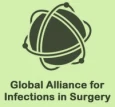Despite current antimicrobial stewardship programs (ASPs) being advocated by infectious disease specialists and discussed by national and international policy makers, ASPs coverage remains limited to only certain hospitals as well as specific service lines within hospitals [1]. ASPs incorporate a variety of strategies to optimize antimicrobial use in the hospital yet the exact set of interventions essential to ASP success remains unknown. Promotion of ASPs across clinical practice is crucial to their success to ensure standardization of antimicrobial use within an institution. The preferable means of improving antimicrobial stewardship is to involve a comprehensive program that incorporates collaboration among various specialties within a healthcare institution. In this context, the direct involvement of prescribers in ASPs can be highly impactful. Even if in 2013 Duane et al. [2] showed poor compliance of surgical services with ASP recommendations; this was especially true for interventions targeting selective pressure. The authors concluded that by identifying services that are less compliant, programs could target their educational efforts to improve outcomes.
Interventions to improve antibiotic prescribing practices for patients with surgical infections should be directed at two different levels [3]:
- Patient level – which includes clinical severity, epidemiological exposures, PK/PD factors, comorbidities, prior antibiotic exposure, prior infection, or colonization with MDROs and infection source
- Hospital level – which includes presence of in-hospital antimicrobial stewardship programs, availability of local guidelines and updated microbiological data, infection control policy, educational activities, and structural resources (like computer-assisted order entry).
Significant data support the importance of antibiotic prescribing practices for patients with surgical infections, in critically ill and non-critically ill patients and in community and hospital-acquired infections. Prescribing practices may influence the outcome and cost of treatment as well as the risk of some emerging infections (such as C. difficile) and resistant pathogens in the individual patient and the broader environment.
Components of antibiotic prescribing practices that may influence outcome and the risk of developing superinfection and antibiotic resistant infections include
- Adequacy of empiric antibiotic therapy,
- Time to initial antibiotic therapy,
- Appropriate pharmacokinetic dosing,
- Reassessment of antibiotic therapy,
- Length of treatment, and
- Avoidance of unnecessary antibiotic therapy.
Multifaceted interventions are more likely to improve antibiotic prescribing practices than simple, passive interventions. Didactic educational programs alone are generally ineffective.
Most studies of the implementation of guidelines and prescribing practices, including for intra-abdominal infections (IAIs), have involved multifaceted interventions. A longitudinal study of a multifaceted program demonstrated compliance with protocols and a sustained reduction in multidrug-resistant pathogens.
Popovski et al. performed a before-and-after study that examined multifaceted interventions to optimize antibiotic use for IAIs. Interventions included:
- Adapting published guidelines based on local susceptibility data with stratification of infection type,
- Creation of educational tools, and
- Educational programs involving multidisciplinary groups
When patients with IAI were compared before the intervention (April-November 2010) to those after implementation of the guideline (April-November 2011) in a surgical unit at a tertiary care teaching hospital, they found a significant reduction in the proportion of patients who received ciprofloxacin therapy. Also, a reduction in the DOT/1000 PD for piperacillin/tazobactam was demonstrated (from 116 to 67; OR 0.6, 95% CI 0.5-0.7).
The difficulty of altering prolonged antibiotic therapy is highlighted by a recent randomized, controlled trial [4] of a short, fixed duration of antibiotic therapy for IAIs versus treatment until the resolution of fever, leukocytosis, and ileus in which both the control and treatment groups had substantial non-compliance with significant extended antibiotic therapy.
As a single intervention, implementation of locally adapted, interdisciplinary evidence based guidelines that incorporate risk stratification (severity and CA-IAIs versus HA-IAIs) and local resistance data most consistently improves components of AB prescribing for surgical infections [5].
As an individual component of change, the creation of locally adapted evidence-based guidelines incorporating local historical culture data with the involvement of an interdisciplinary team is strongly supported in the literature.
A retrospective study by Sartelli et al. [6] showed that implementation of an education-based ASP achieved a significant improvement in all antimicrobial agent prescriptions and a reduction in antimicrobial drug consumption. In a surgical unit performing mainly elective major abdominal surgery and emergency surgery, they introduced both a local protocol of surgical prophylaxis and a set of guidelines for management of intra-abdominal infections (IAIs) and control of antimicrobial agent use. Comparing the pre-intervention and post-intervention periods, the mean total monthly antimicrobial use decreased by 18.8%, from 1,074.9 defined daily doses (DDD) per 1,000 patient-days to 873.0 DDD per 1,000 patient-days after the intervention. There was a significant reduction of the use of group 2 carbapenems including imipenem/cilastatin and meropenem, and ciprofloxacin.
References
Sartelli M, Weber DG, Ruppé E, et al. Antimicrobials: a global alliance for optimizing their rational use in intra-abdominal infections (AGORA). World J Emerg Surg. 2016 Jul 15;11:33.
Duane TM, Zuo JX, Wolfe LG, et al. Surgeons do not listen: evaluation of compliance with antimicrobial stewardship program recommendations. Am Surg 2013;79:1269-1272.
Popovski Z, Mercuri M, Main C, et al. Multifaceted intervention to optimize antibiotic use for intra-abdominal infections. J Antimicrob Chemother 2015;70:1226-1229.
Sawyer RG, Claridge JA, Nathens AB, et al. Trial of short-course antimicrobial therapy for intraabdominal infection. N Engl J Med. 2015;372:1996 –2005.
Sartelli M, Duane TM, Catena F, et al. Antimicrobial Stewardship: A Call to Action for Surgeons. Surg Infect (Larchmt). 2016 Dec;17(6):625-631.
Sartelli M, Labricciosa FM, Scoccia L, et al. Non-Restrictive Antimicrobial Stewardship Program in a General and Emergency Surgery Unit. Surg Infect (Larchmt) 2016;17:485-490.
